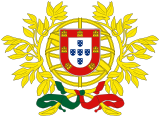
Back Freguesía AN Freguesia AST Freguesia Catalan Freguesia Danish Freguesia German Freguesia Esperanto Freguesia Spanish Freguesia Basque Freguesia Finnish Freguesia French
| Freguesia | |
|---|---|
| Category | 3rd-level administrative division |
| Location | Portugal |
| Found in | Municipality |
| Created |
|
| Number | 3,091 |
| Government | |
 |
|---|
| Constitution |
Freguesia (Portuguese pronunciation: [fɾɛɣɨˈzi.ɐ]), usually translated as "parish" or "civil parish", is the third-level administrative subdivision of Portugal, as defined by the 1976 Constitution.[1] It is also the designation for local government jurisdictions in the former Portuguese overseas territories of Cape Verde and Macau (until 2001). In the past, it was also an administrative division of the other Portuguese overseas territories. The civil parishes and communities in England and Wales and parroquia in the Spanish autonomous communities of Galicia and Asturias is similar to a freguesia in Portugal. The average land area of a Portuguese parish is about 29.83 km2 (11.52 sq mi) and an average population of about 3,386 people. The largest parish by area is Alcácer do Sal (Santa Maria do Castelo e Santiago) e Santa Susana, with a land area of 888.35 km2 (342.99 sq mi), and the smallest parish by area is São Bartolomeu (Borba), with a land area of 0.208 km2 (0.080 sq mi). The most populous parish is Algueirão - Mem Martins, with a population of 68,649 people and the least populous is Mosteiro, with a population of just nineteen people.
A freguesia is a subdivision of a município (municipality), which is a cluster of freguesias, like a US county. Most often, a parish takes the name of its seat, which is usually the most important (or the single) human agglomeration within its area, which can be a neighbourhood or city district, a group of hamlets, a village, a town or an entire city. In cases where the seat is itself divided into more than one parish, each one takes the name of a landmark within its area or of the patron saint from the usually coterminous Catholic parish (paróquia in Portuguese). Be it a city district or village, the civil parish is often based on an ecclesiastical parish.
Since the creation of a democratic local administration, in 1976, the Portuguese parishes have been ruled by a system composed by an executive body (the junta de freguesia, "parish board/council") and a deliberative body (the assembleia de freguesia, "parish assembly"). The members of the assembleia de freguesia are publicly elected every four years. The presidents of the parish boards are also members of the municipal assembly.[1]
- ^ a b "7th Constitutional Revision" (PDF). Assembly of the Republic (Portugal). Archived from the original (PDF) on 22 October 2014. Retrieved 13 August 2014.